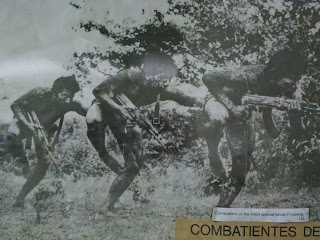As a mental health care provider trained in the US, it is important for me to recognize the many differences in the conceptualizations and treatment approaches across cultures. Since the majority of my work has been with immigrants from Latin America, I have learned a great deal about how to adjust paradigms and approaches to provide culturally competent care. This trip to El Salvador provided me the opportunity to understand mental health as it is constructed both theoretically and practically within the Salvadorian cultural context.
The approach of the San Luis pastoral team in Morazan could be viewed as a community mental health approach. Guided by their faith in Liberation Theology and their close connection to the Martyrs of the revolution, they work with youth in "value development". This consists of education, consistent engagement, youth activities, and general support. In a conversation with two of the women carrying out this work, they described the youth most in need of their services are those whose parents have left for the US. (Read more about this complex issue in my previous post on Family Separation.) The leaders of this team are doing continual outreach to these youth and their caretakers to envelop them into the community.
In Amando Lopez, the democratically elected collective of leaders serve the community with supportive guidance in addition to their executive duties. I see this too as a culturally accepted way to address the trauma experienced by the war and the ongoing security threats of violence, poverty, and the resulting separation of families. In contrast to the US individual mental health approach,community settings offer a socially accepted space to share and receive support. This works particularly well when a community has experienced, or is experiencing, a collective trauma, such as those listed above.
When I inquired about individual therapeutic approaches, many people either stated it wasn’t available or it was too stigmatized for people to utilize. A surviving family member of the Mozote massacre shared she recently sought out a psychologist for her granddaughter after she experienced trauma similar to what the grandmother had gone through as a youth, yet this seemed to be a rarity and after all of the trauma she shared about her own life I question whether she considered seeking support for herself as well. In the schools we visited, all of the teachers seemed to recognize the need for therapeutic services, but lamented the lack of access to mental health professionals, which seemed a luxury when teachers are scarcely paid.
With the scarcity of formal mental health care, I found myself looking for the intangible factors that support resiliency in El Salvador. What I witnessed was humbling and inspiring. I saw and felt HOPE; people continuing to strive while confronting obstacle after obstacle. Not a blind faith, nor an ignorance of the realities to be overcome, but a genuine belief in the capacity of the people to flourish. Teachers showing up day after day with very little resources, overflowing classrooms, minimal pay and no guarantee the situation will improve. Community members voluntarily taking on leadership roles to care for their neighbors in spite of potential threat to their own livelihood and personal safety. Speaking honestly about the political system and the gang issues in the face of very real danger. Through these actions, LOVE of one’s people and country was more than evident. Refugee camps in Honduras during the civil war created tight knit self-reliablecommunities. Organizations like Voices on the Border have continued to support COMMUNITY through the transitions back to El Salvador and to work for peace and prosperity despite extreme obstacles. Many of these communities are rooted in FAITH based on Liberation Theology via the highly adored martyrs of the revolution, such as Monseñor Oscar Romero, who continue to inspire and motivate the people to work for justice. The ongoing presence of these martyrs in their lives and gratitude for their sacrifices cannot be understated.
I have nothing but respect and appreciation for those who taught me so much about mental health and resiliency in El Salvador. The HOPE, LOVE, COMMUNITY, FAITH, and INDESTRUCTIBLE SPIRIT of the people is undeniable and radiated throughout our brief time there. I look forward to lasting bonds of solidarity with Voices and the communities that welcomed us.

















































